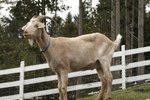There's quite a few ways to make money with your caprine companions. Some of these ventures require specific types of goats, while any goat can participate in others -- such as brush clearing.
Tips
Making money with goats can save you money on taxes. You may depreciate capital equipment used in farming for federal tax purposes, and may qualify for lower farm assessment taxes under state or local ordinances.
Weed and Brush Control
For landowners or municipalities looking for an environmentally friendly way to keep property clear of brush and weeds, goats can fill the bill. Getting started requires obtaining a livestock trailer and suitable tow vehicle, if you don't already have these items. Other necessities include:
- A livestock tank for water
- Brush hog, commercial trimmers and cutters for portable fence installation
- Portable shelters
- Electric fencing and portable posts to keep goats in and predators out.
- Solar or battery-powered fence chargers.
For best results, use wethers -- or castrated males -- because reproduction or the urge to reproduce isn't an issue. If you use does, those not currently pregnant or nursing are a good choice. Does nursing kids spend less time eating brush, and kids are the most vulnerable to predators. Larger goats, often dairy/meat breed crosses, are the most efficient weed and brush consumers.
Warnings
You must comply with all local laws when renting your goats for weed and brush control. Make sure you are familiar with any animal care regulations specific to the community. If you note any potential conflicts between the reality of caprine brush work and local statutes, clear those issues with authorities before commencing the job.
Fiber Goats
Two luxury fabrics -- cashmere and mohair -- come from caprines. The former is the undercoat from a variety of breeds -- other than the Angora -- and the combing out of the material is quite labor-intensive. The demand for solid gray, white or brown goat hair outweighs that of multicolored hair. Mohair is the product of Angora goats, and is clipped off, making the hair harvesting much easier. The yield is far greater than cashmere, and the Angora goat's hair can be clipped semi-annually.
If you have a large herd, contact your local agricultural extension agency for information on marketing fiber goats, or the Cashmere and Camel Hair Manufacturers Institute regarding cashmere production. If your herd is relatively small, consider selling the raw fiber through a farming cooperative or selling the fiber directly to consumers via a website or farmers market.
Dairy and Other Products
While dairy products made from goat's milk are still a niche market compared to cow's milk, that niche is growing. In addition to milk and cheese, there's a market for goat yogurt and ice cream. Goat milk contains lower cholesterol but more protein than milk from cows. Handmade soap derived from goat's milk is gentle on sensitive skin and appreciated by those seeking natural beauty products.
Making money off dairy goats requires raising the appropriate breeds. These include:
- Toggenburg
- Nubian
- Oberhasli
- Alpine
- LaMancha
- Saanen
Of course, running a caprine dairy requires regular breeding of does and kidding. Since many of those kids will be male, consider providing wethers to goat weed and brush control contractors. You may want to sell your dairy wares to farmers markets, directly to the public via a website or directly to restaurants and specialty-food stores.
Writer Bio
Jane Meggitt has been a writer for more than 20 years. In addition to reporting for a major newspaper chain, she has been published in "Horse News," "Suburban Classic," "Hoof Beats," "Equine Journal" and other publications. She has a Bachelor of Arts in English from New York University and an Associate of Arts from the American Academy of Dramatics Arts, New York City.





